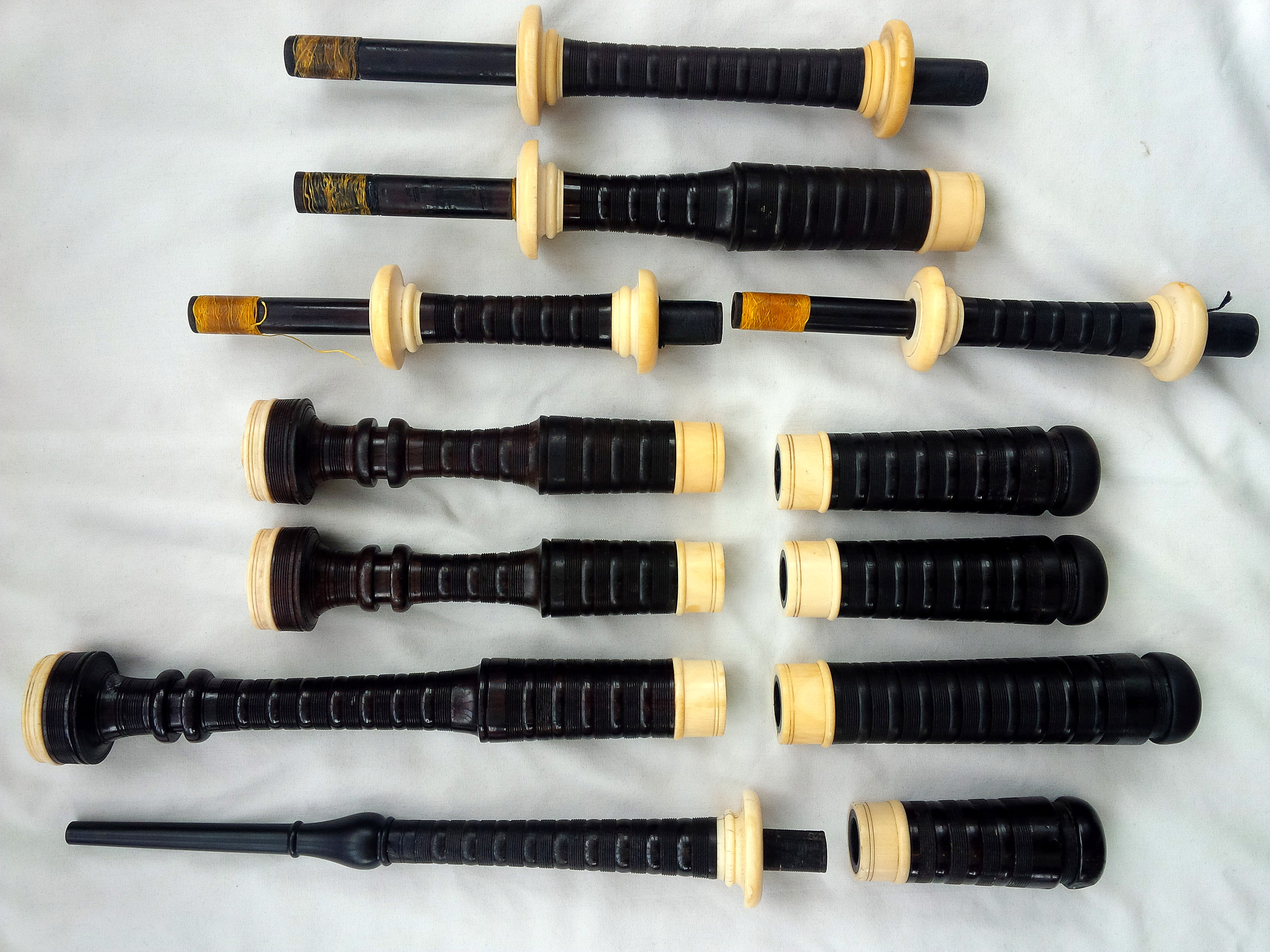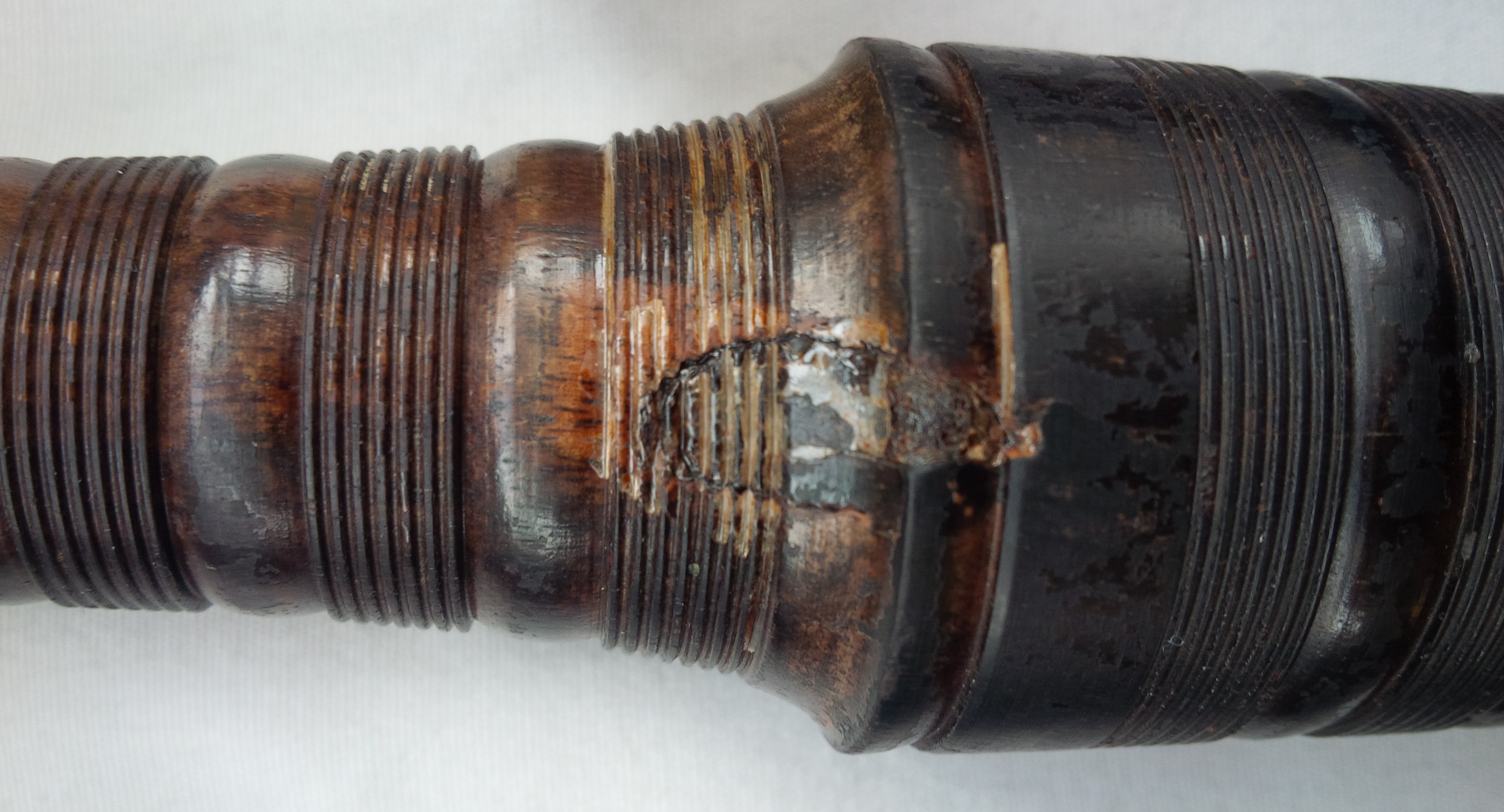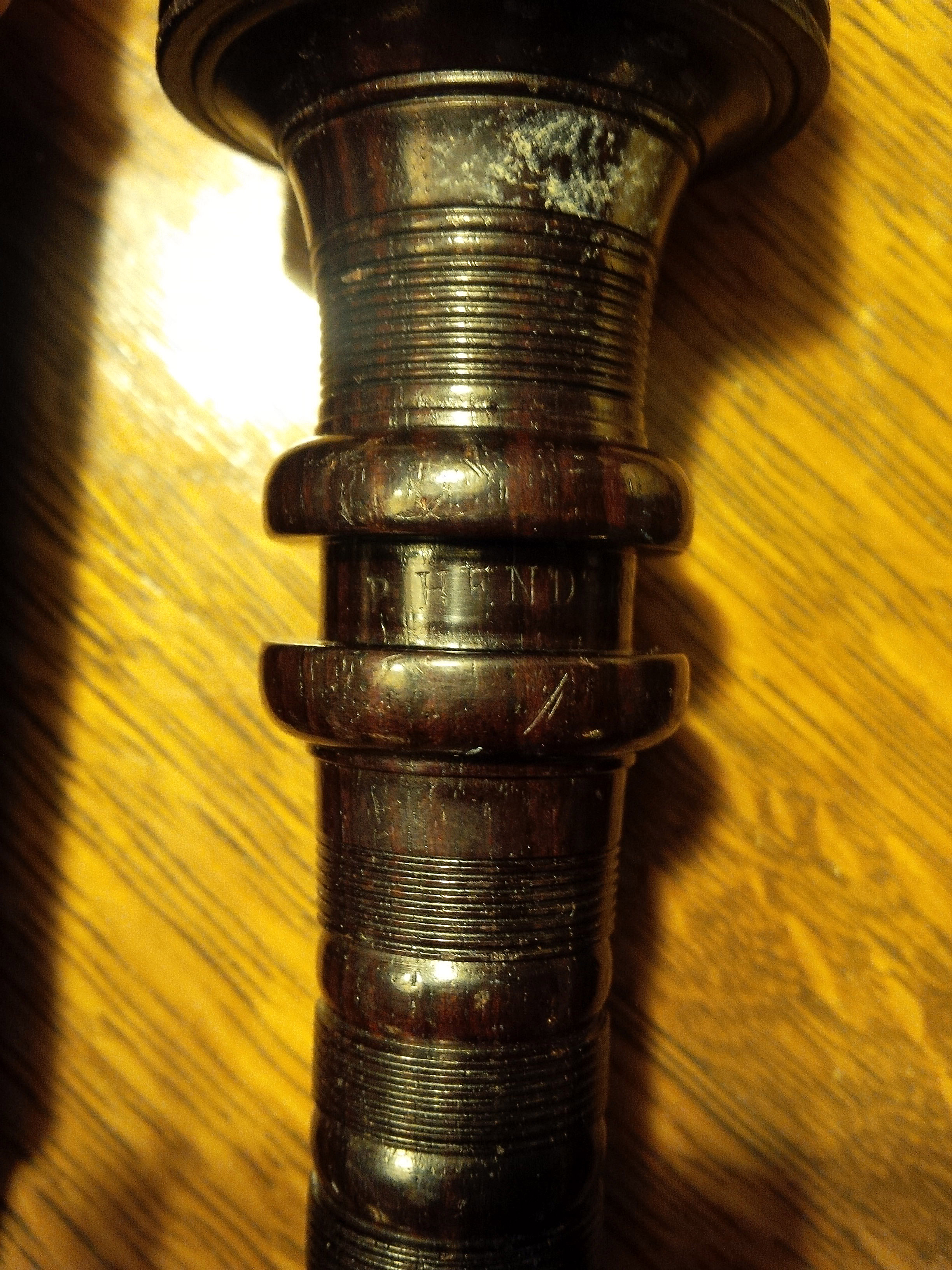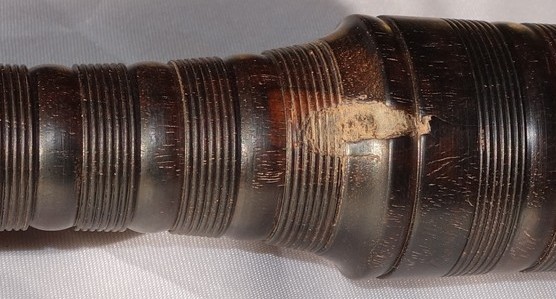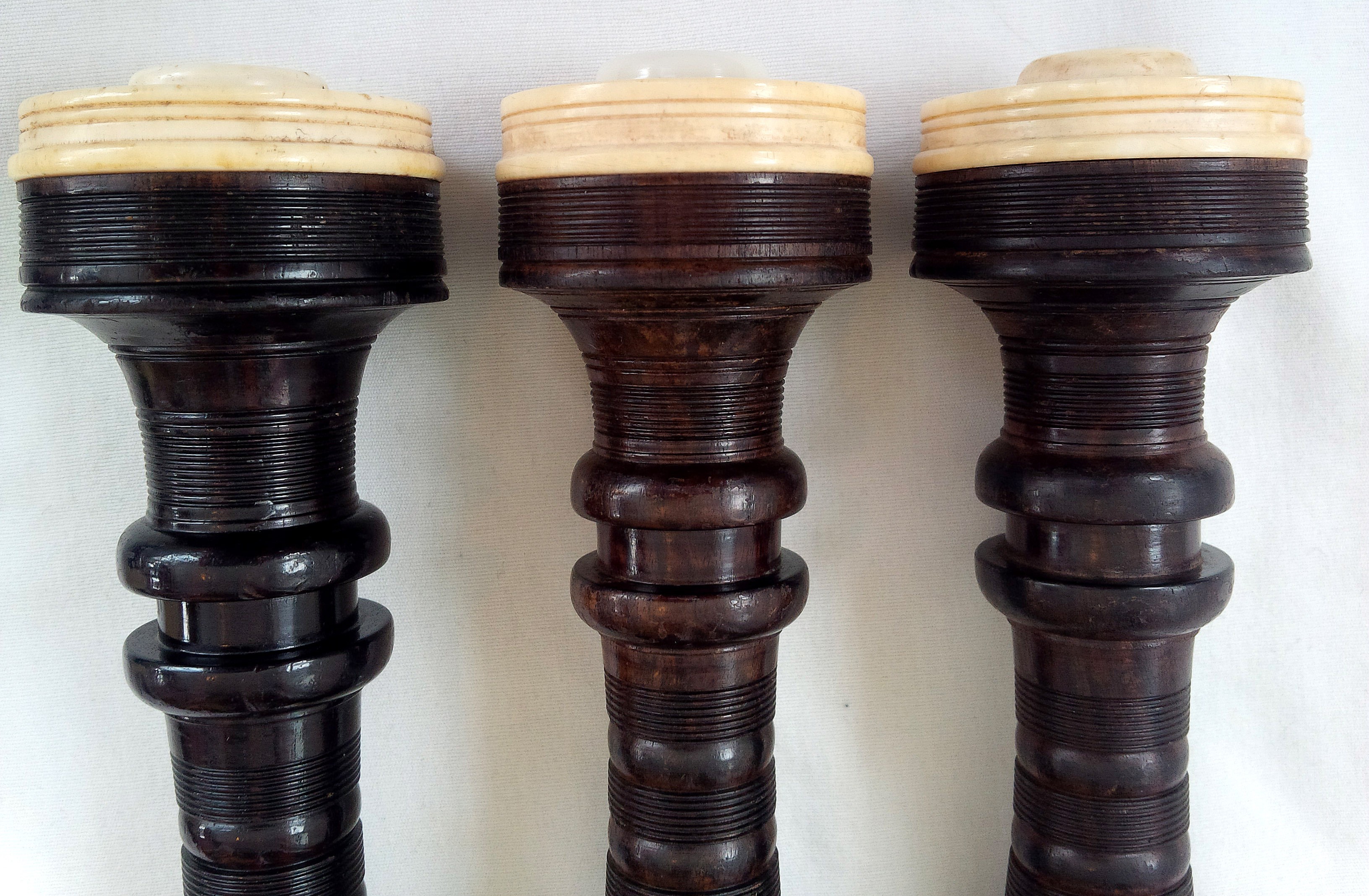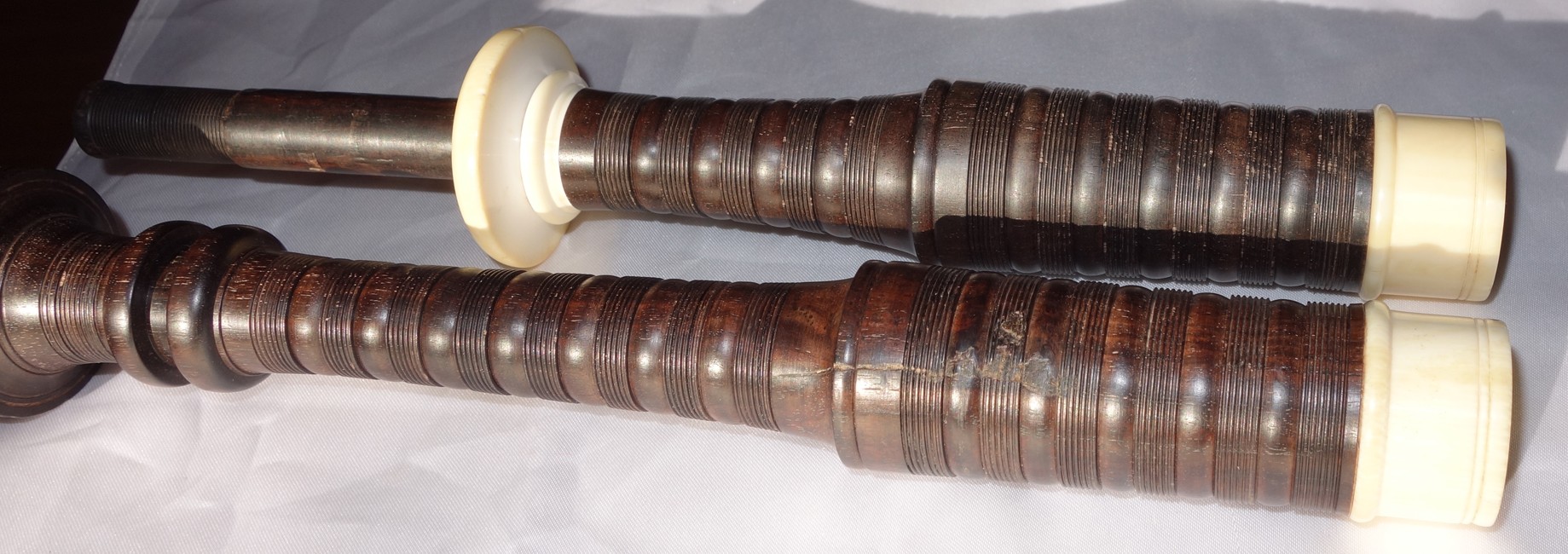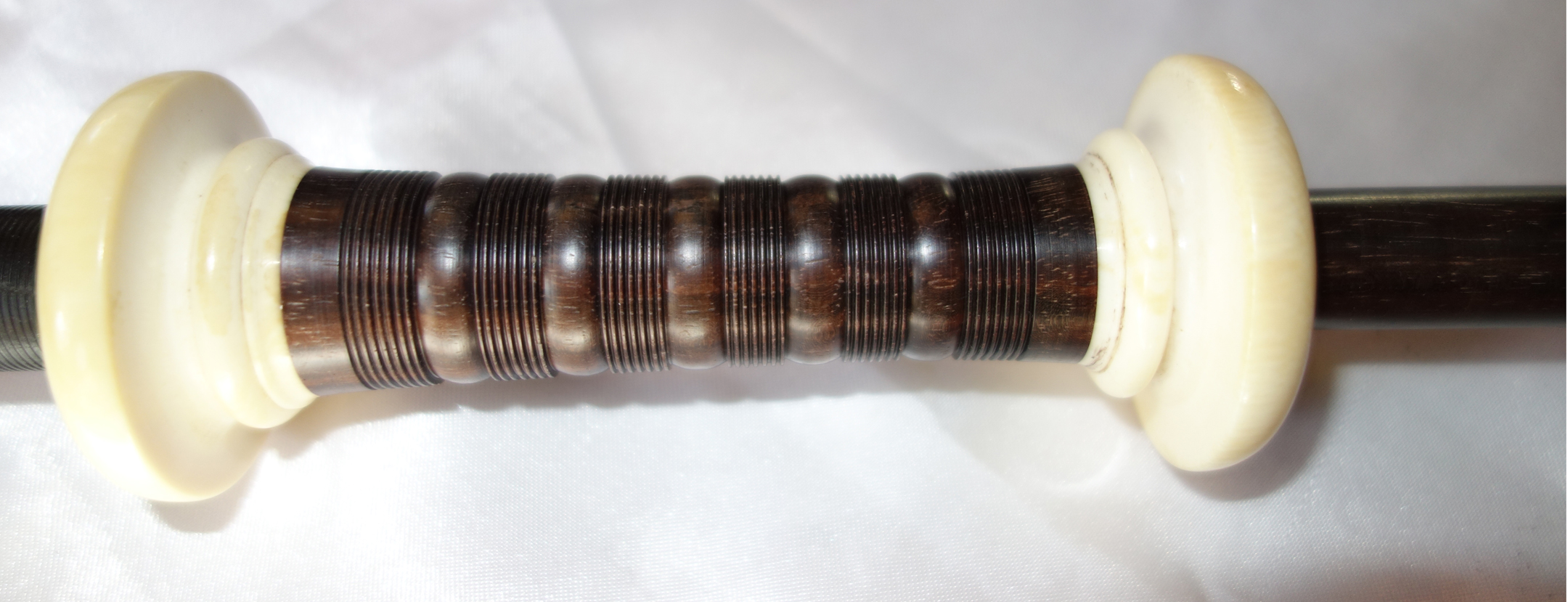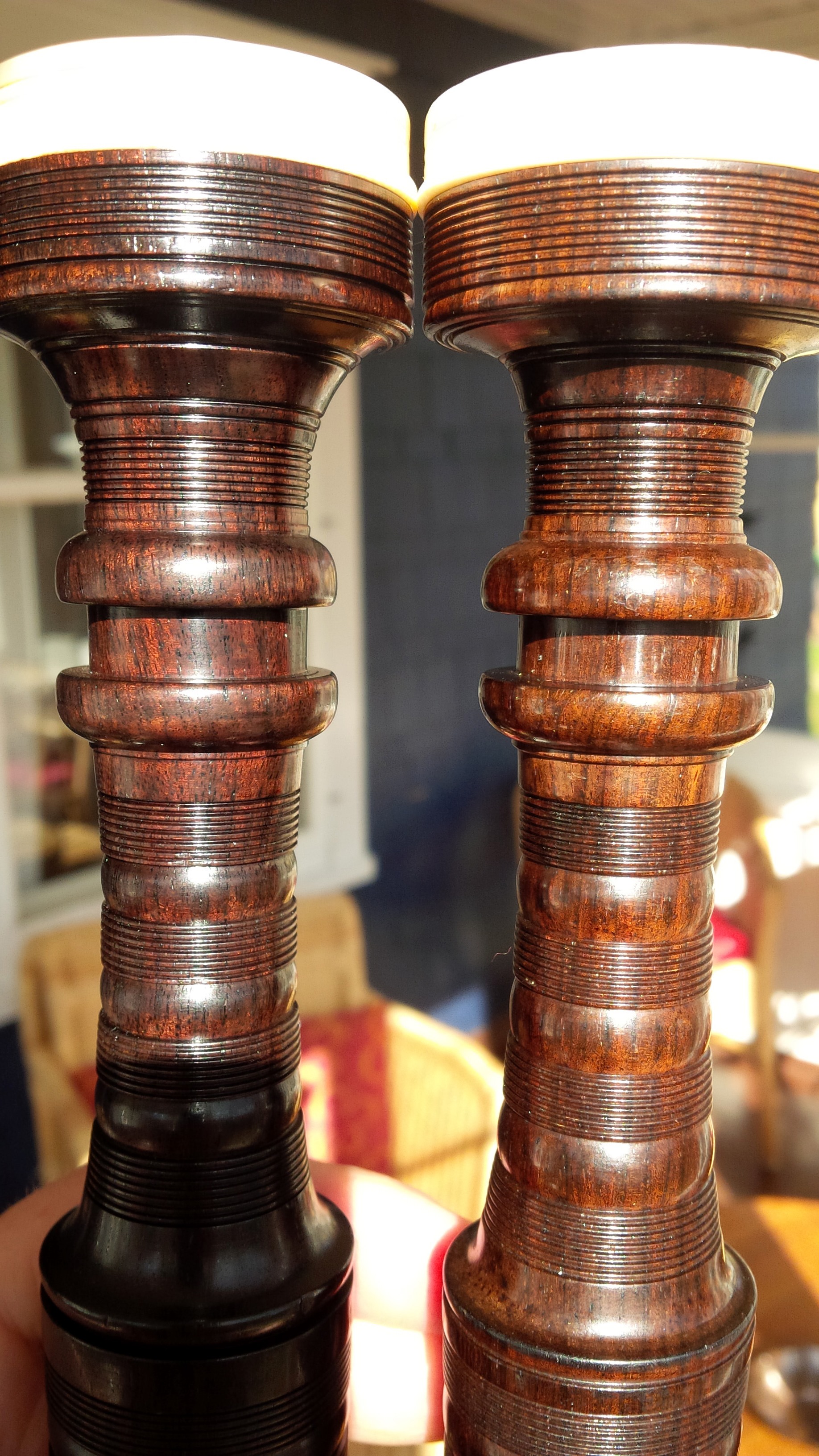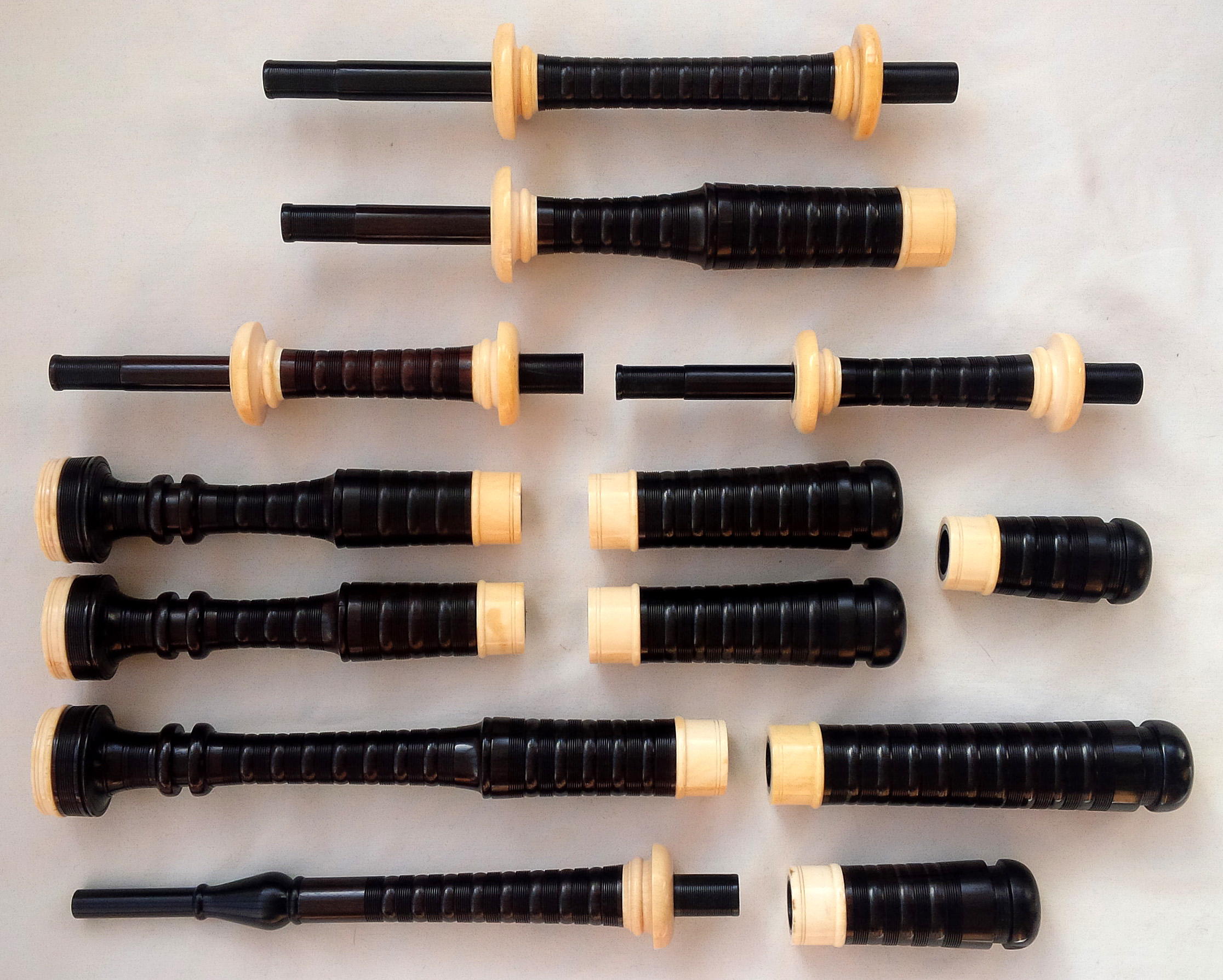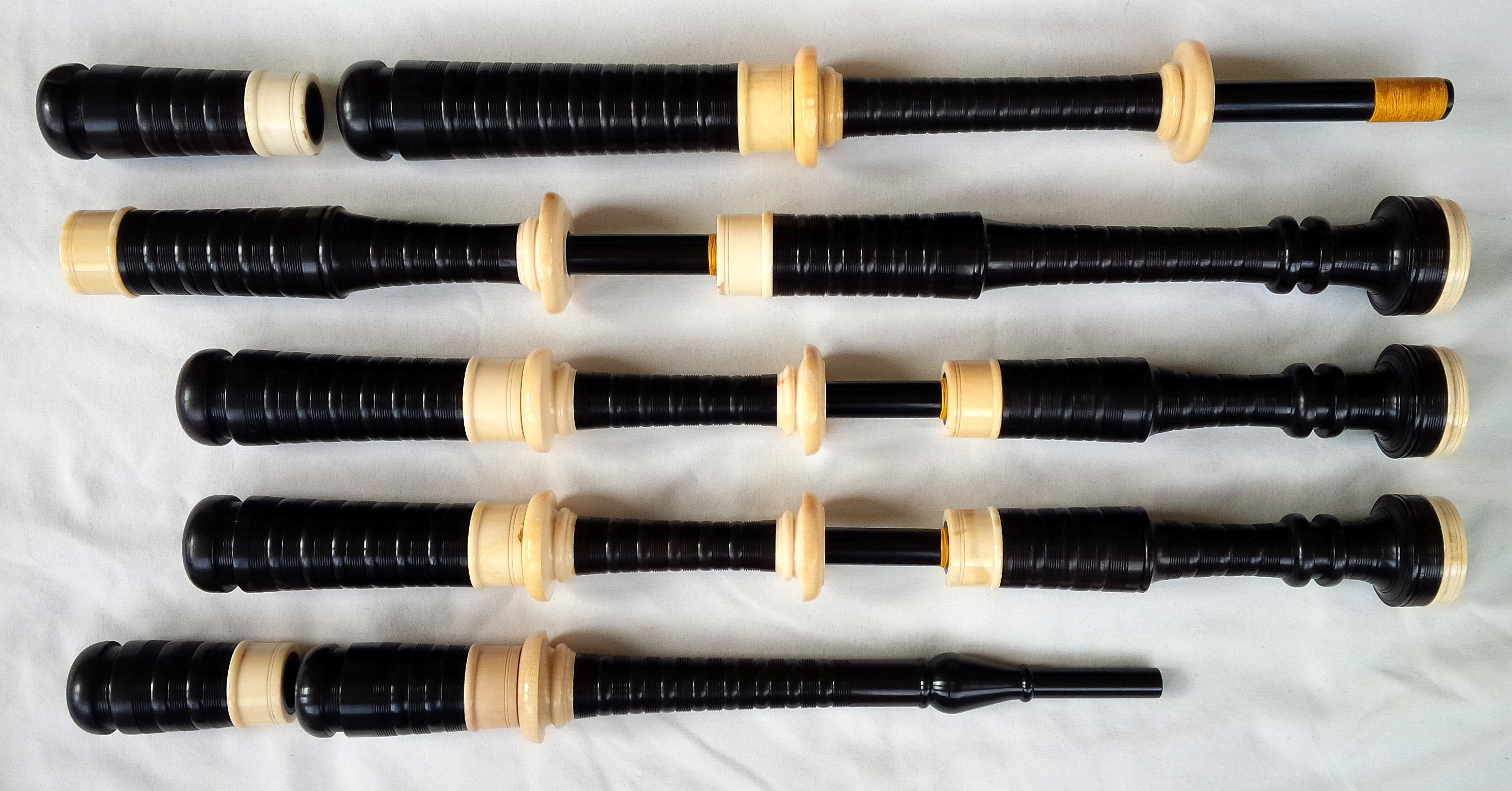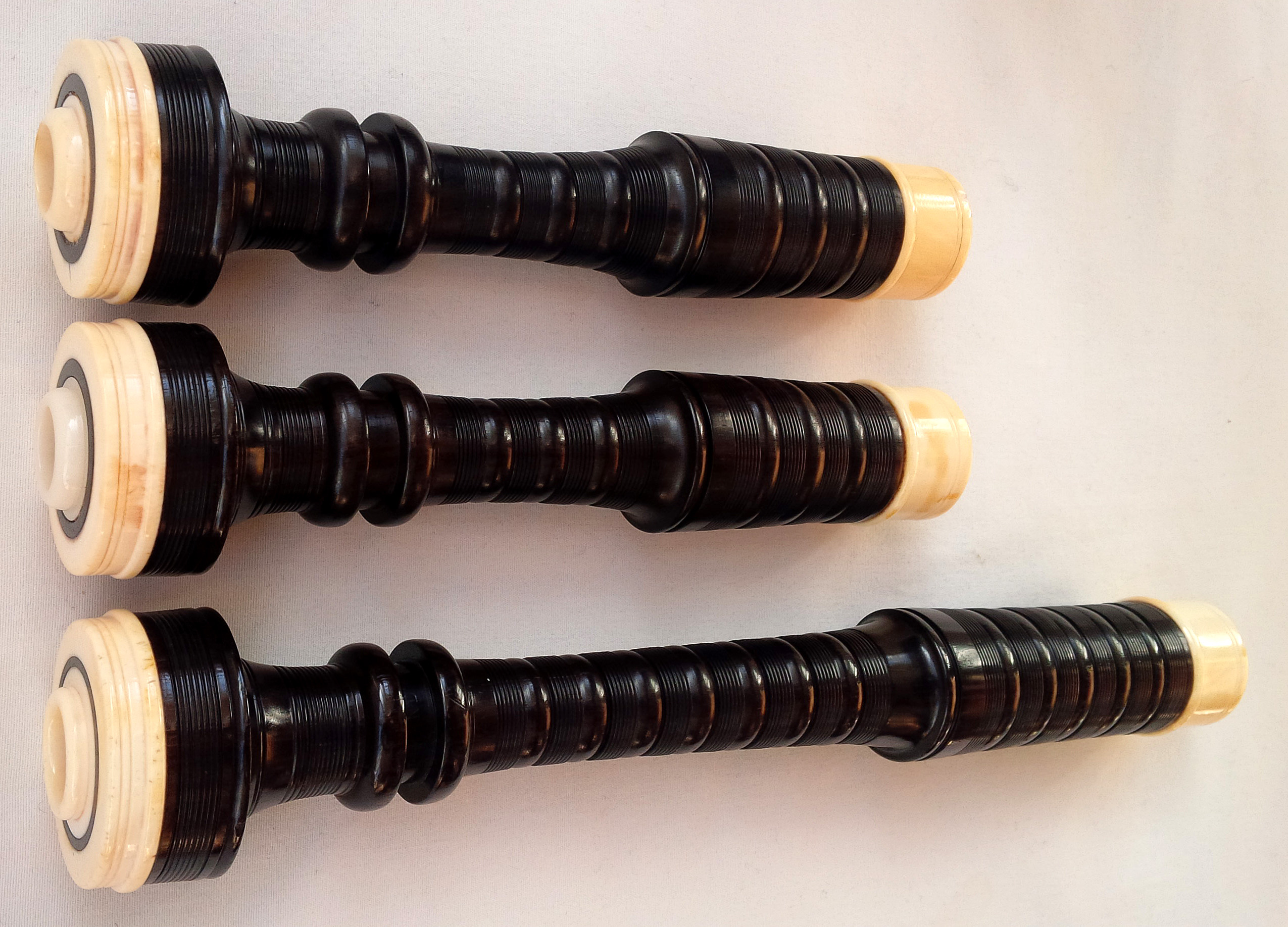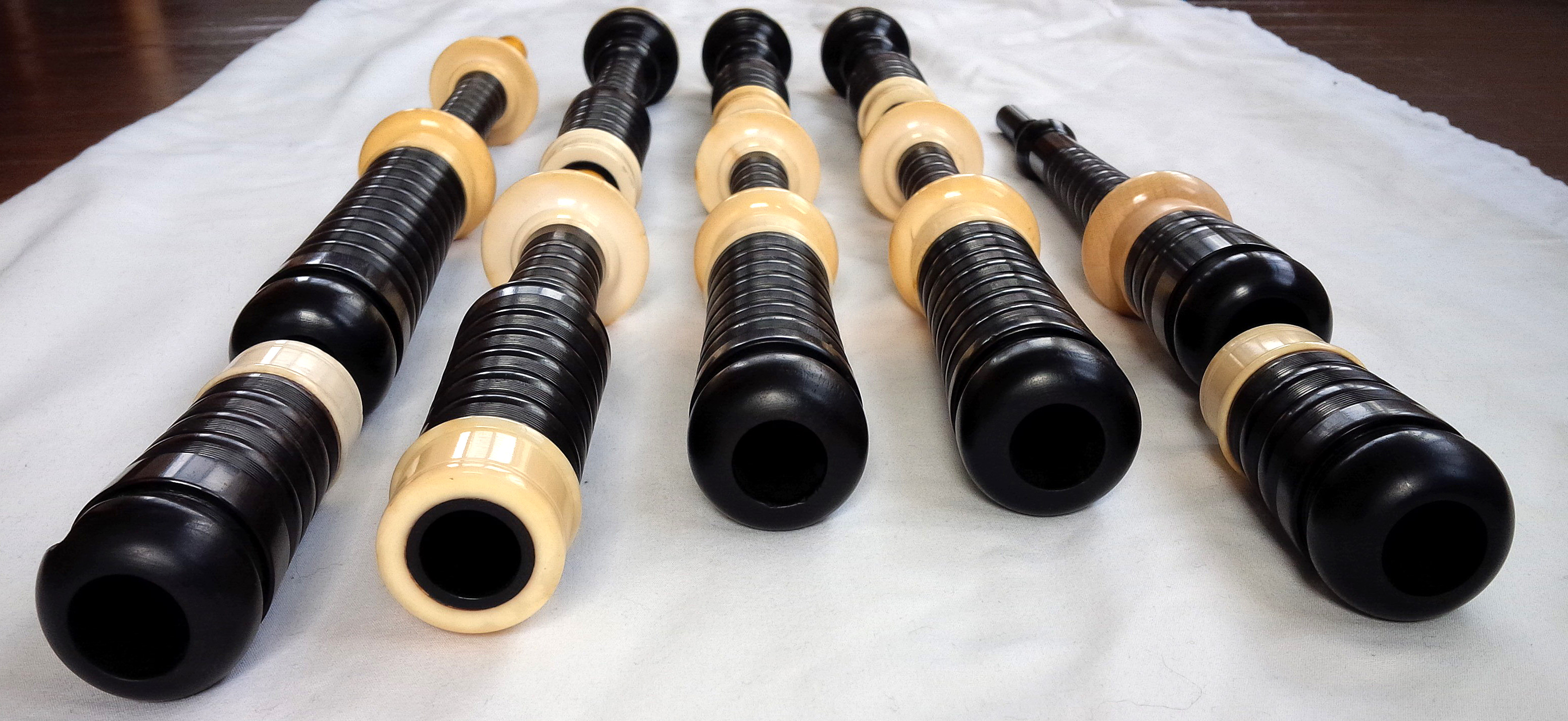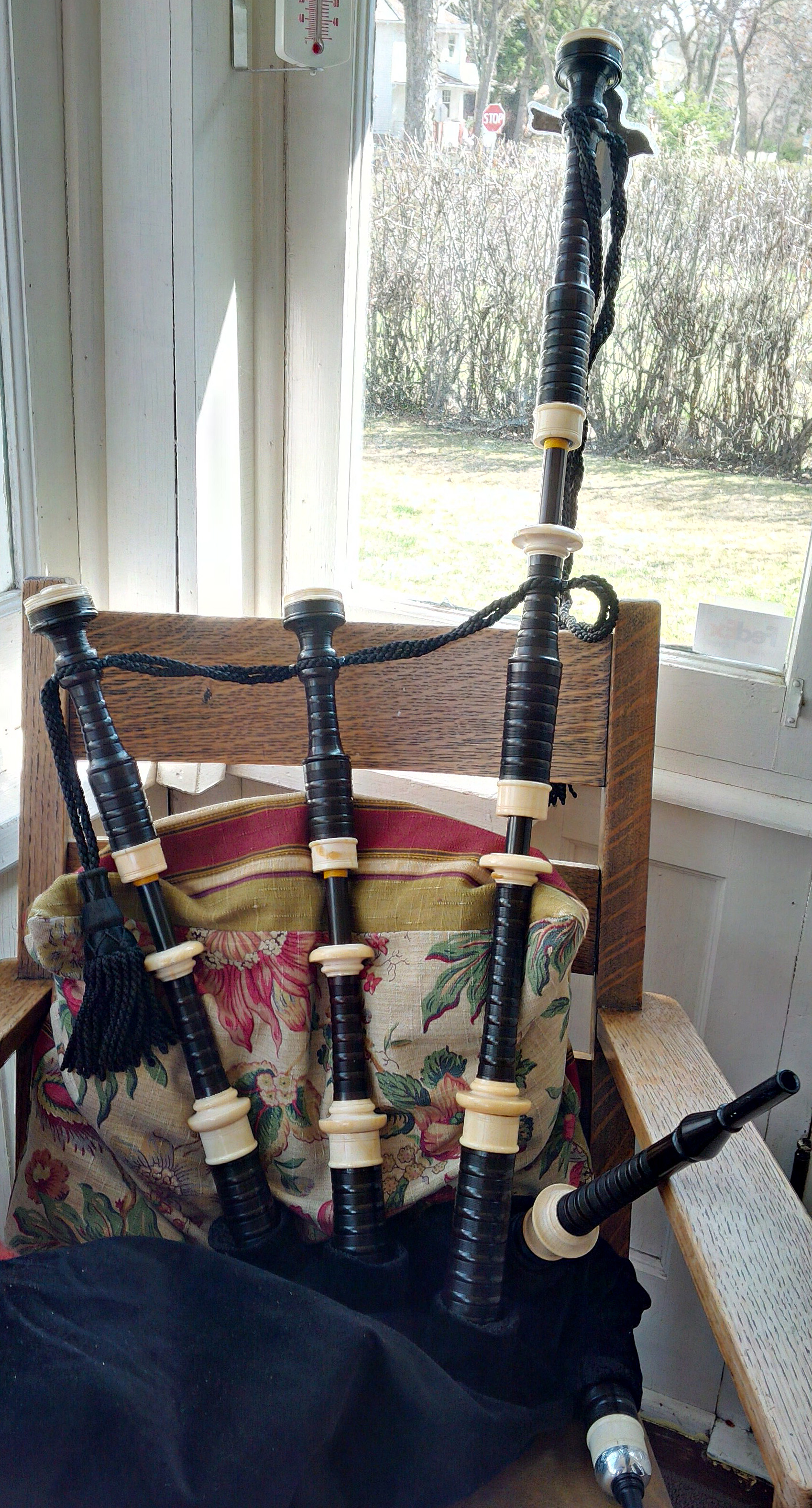I recently acquired a set of ivory-mounted bagpipes that were sold to me as 1920 vintage Lawries. The seller is a grade 1 piper who purchased them on Gumtree while living in Scotland. The pipes were the property of a piper for many years who played with Lothian and Borders and the Newton Grange Pipes Bands. His descendents sold them as Lawries to the piper I purchased them from. These were then taken to a reputable Scottish pipe manufacturer who suggested they were circa 1920s Lawries; as far as everyone knew, these were Lawries.
The pipes have been well-used but were pretty much intact with all of the original pieces (the blowpipe stock was later mailed to me). The blowpipe appears to be ebony and is a vintage replacement.
How about the condition of the pipes? Fine, more or less, but there are a number of interesting ‘scars’ that made me hesitant to purchase these. Most of these scars are ‘patches’ such as shown below on the tenor drone; this is the worst of four or five patches on the pipes.
Despite the patches, I decided to take a chance and purchase the pipes. They are a near complete set of vintage pipes with ivory. The pipes are described as very steady by the previous owner who played them recently at The Worlds. And the pipes, IMHO, sound quite divine — a rich tone, deep bass, and lovely harmonics — here’s a cellphone video converted to sound file of the previous owner playing these in my living room (Chris Armstrong reeds, McCallum blackwood chanter with G1 Platinum reed, sheepskin bag).
Lawries or Something Else?
After I took possession of the pipes I removed the cords — look what I found stamped in the cord guide groove: P. Henderson!
I could see that these pipes, at least the bass drone, are Peter Henderson! What about the rest of the pipes? I posted images on the Bob Dunsire forum and the comments and opinions found there, with some investigation on my own, and confirmation by Ringo Bowen, indicated that the whole set was vintage Peter Henderson.
How could so many people be wrong? Obviously the cords had not been removed in a while or the stamp was not noticed. Apart from that, Hendersons and Lawries, particularly from the earlier years, can apparently be easily confused with each other. The two companies purportedly shared turners and there is conjecture that Robert Lawrie first worked with Peter Henderson at the Henderson Shop. And to some degree, IMHO, early Hendersons and Lawries appear more similar to each in the early years than later years. See this page on my site for more information on the similarities and differences between Henderson and Lawrie, and Hardie.
I wasn’t certain what to think at first — I had my heart set on Lawries. I soon got over it, though — they are Hendersons. But there were more questions. What were those patches, how old were the pipes, and what type of wood were they constructed of?
WWI ‘Firewood’ Bagpipes
The surprises were not over. Those patches or fixes on these pipes? Ringo Bowen soon answered that after he closely examined them while helping with their restoration. Turns out that wood for bagpipes was in short supply during WWI. To compensate for lack of supply, lesser pieces, those that may have actually gone into the fireplace or stove, were returned to the “good wood” pile for bagpipe construction. ‘Worm-holes’, as Ringo puts it, were filled with a mixture of sawdust and shellac. After finishing these patches were virtually invisible when sold by Henderson. However, with the ravages of time they shrank, shifted, and chipped. Here are two images of the same drone section that has been stripped. You can clearly see the sawdust filling the hole/indentation.
Pretty ugly. A couple even go through to the bores — wow. In a phone conversation, Rick Pettigrew of Dunbar Bagpipes stated that these pipes had the worst case of insect bore holes he had ever seen. Henderson’s must have really been scraping the bottom of the barrel. As bad as they were, these are primarily cosmetic according to Rick, who conducted the restoration of these pipes. The bright side of these patches is that they probably help to date the vintage of these pipes; these Hendersons are very likely WWI-era bagpipes. And, with a good handful of parts having the same patches the components are all likely original to the set. Another surprise awaits.
Cocus wood
After examining some photos of these pipes Ringo had a feeling that they may be cocus wood. I had not really heard about cocus wood before. My reading soon suggested that this was one of the most common woods used for bagpipes pre-1900 and even much later by many manufacturers, along with ebony. African Blackwood did not really become popular until after the 1920s and perhaps later.
Cocus wood is a coveted bagpipe wood that originates in the Caribbean, specifically Jamaica and Cuba. Some believe it is tonally the best for bagpipes when compared to ebony and African blackwood. Unfortunately, instrument grade cocus wood is no longer available at an affordable price. Stocks diminished early in the 20th century and have never rebounded. That said, some individual craftsman continue to use cocus wood and Charlie Kron still lists cocus wood bagpipes in his line-up.
So, are these pipes cocus wood? Here’s an image of the drone tops pre-restoration. Look closely at the reddish bands on the middle drone in particular.
Here are some images of some parts stripped during the restoration process that Ringo conducted:
Cocus wood! And it would appear with the whole set is of this wood (although Ron thinks that the lower bass section could be ebony — it is difficult to tell by my eye: you be the judge in the photos below).
With respect to colour, cocus wood is an interesting material. Depending on the light it can be as black as ebony or as light a cocobolo. In the right light there is an interesting red grain embedded in a chocolate matrix. I suspect that in many cases cocus wood pipes could be misidentified as African blackwood or even ebony. Here’s a comparison of cocus wood and blackwood Henderson tenor tops: my finished WWI cocus wood Hendersons on the left and 1950s – 1960s Hendersons on the right. Note the deep red within the chocolate matrix of the cocus wood. While the grain is quite variable in cocus wood, it appears to me to be comparatively diffuse to blackwood. See photos below in the Refurbishment section.
Refurbishment and Repair
The Henderson pipes as refurbished and repaired by Rick Pettigrew of Dunbar Bagpipes. The refurbishment was definitely a success, IMHO. The cavities were filled, cracks repaired, and the whole set cleaned, buffed, oiled, and sealed. Here are the results:
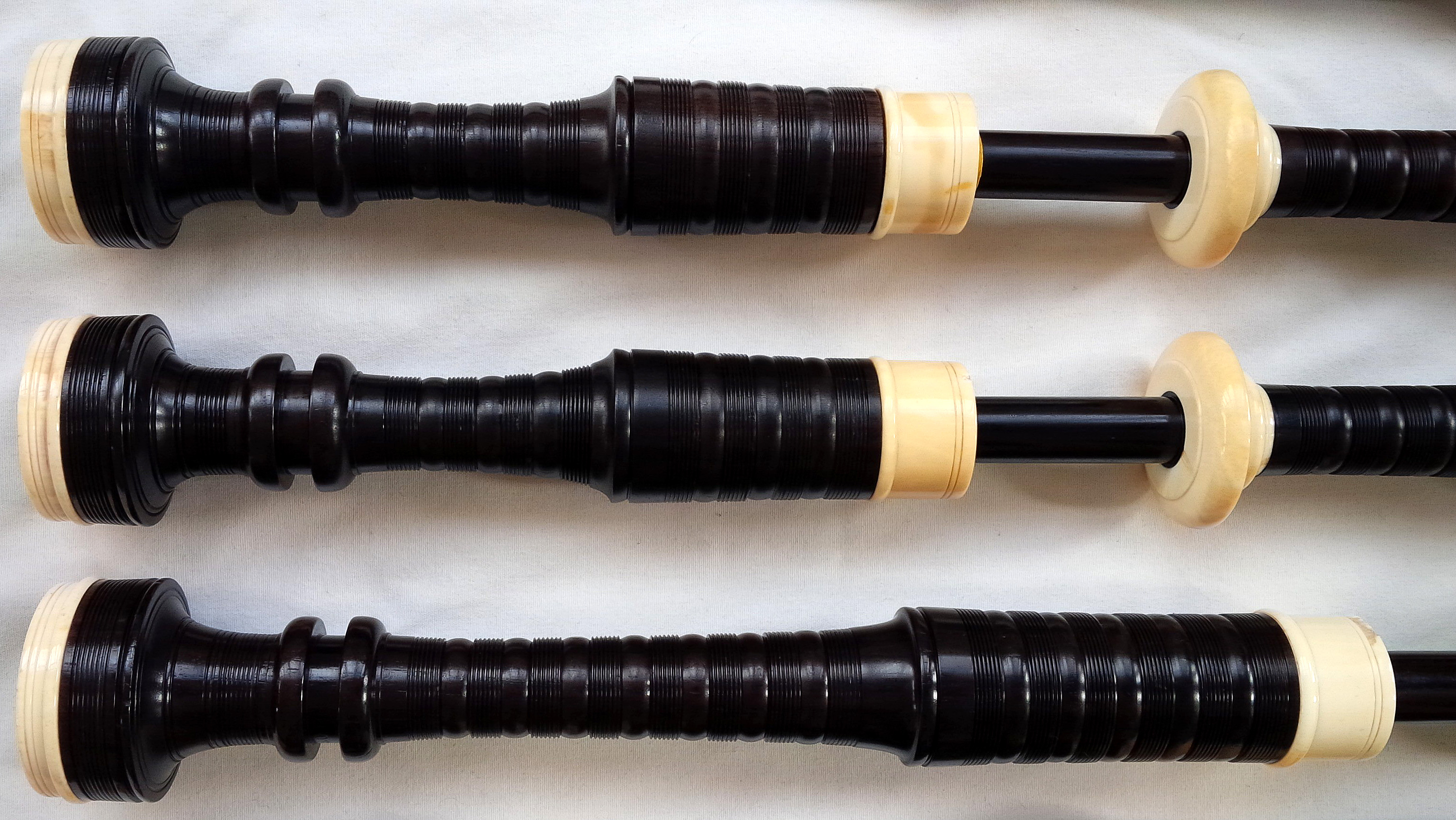
The colours of the cocus wood become more apparent as one zooms in.
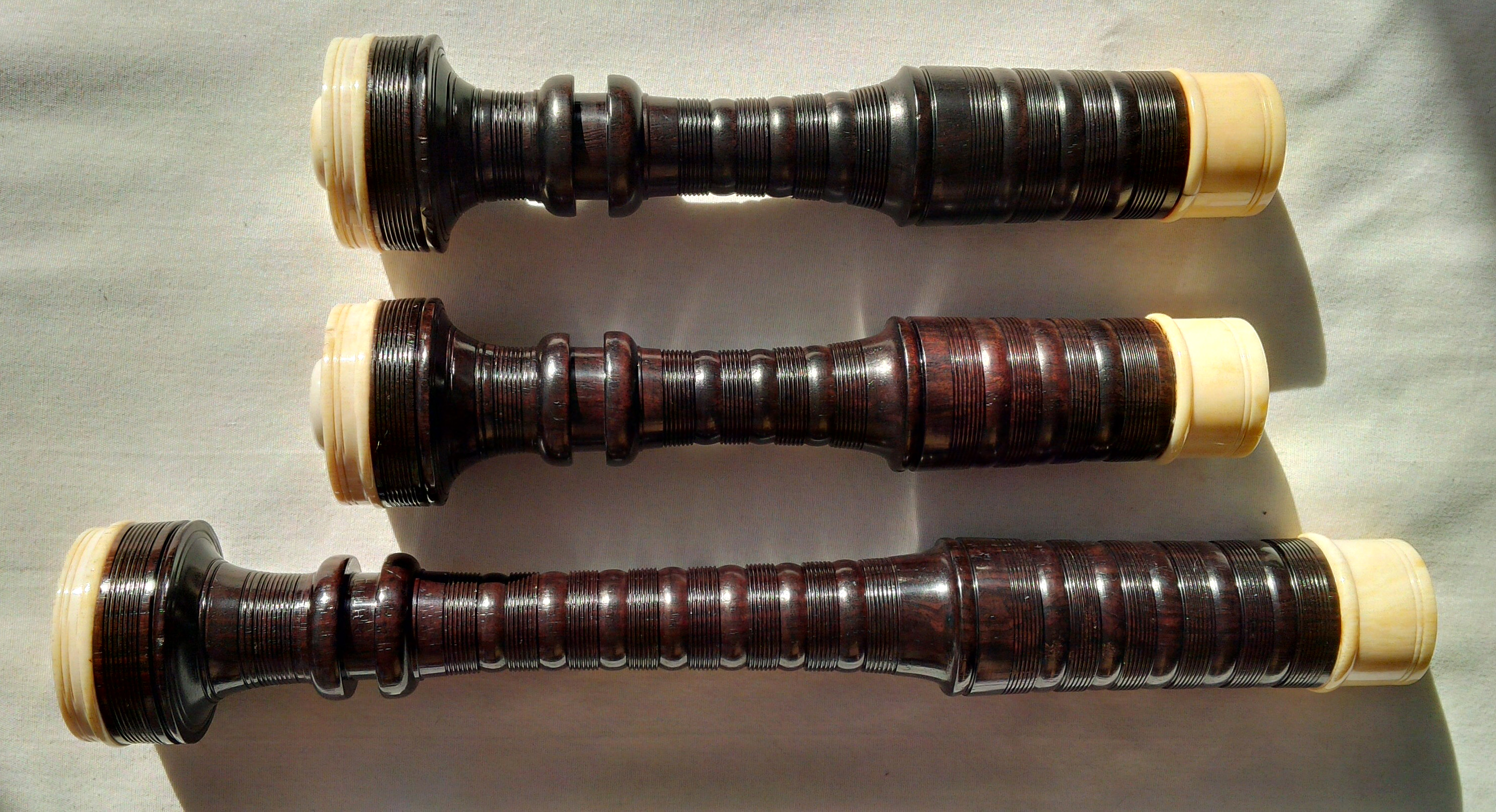
Sunlight on the drone tops pulls of the red from the chocolate background in the cocus wood.
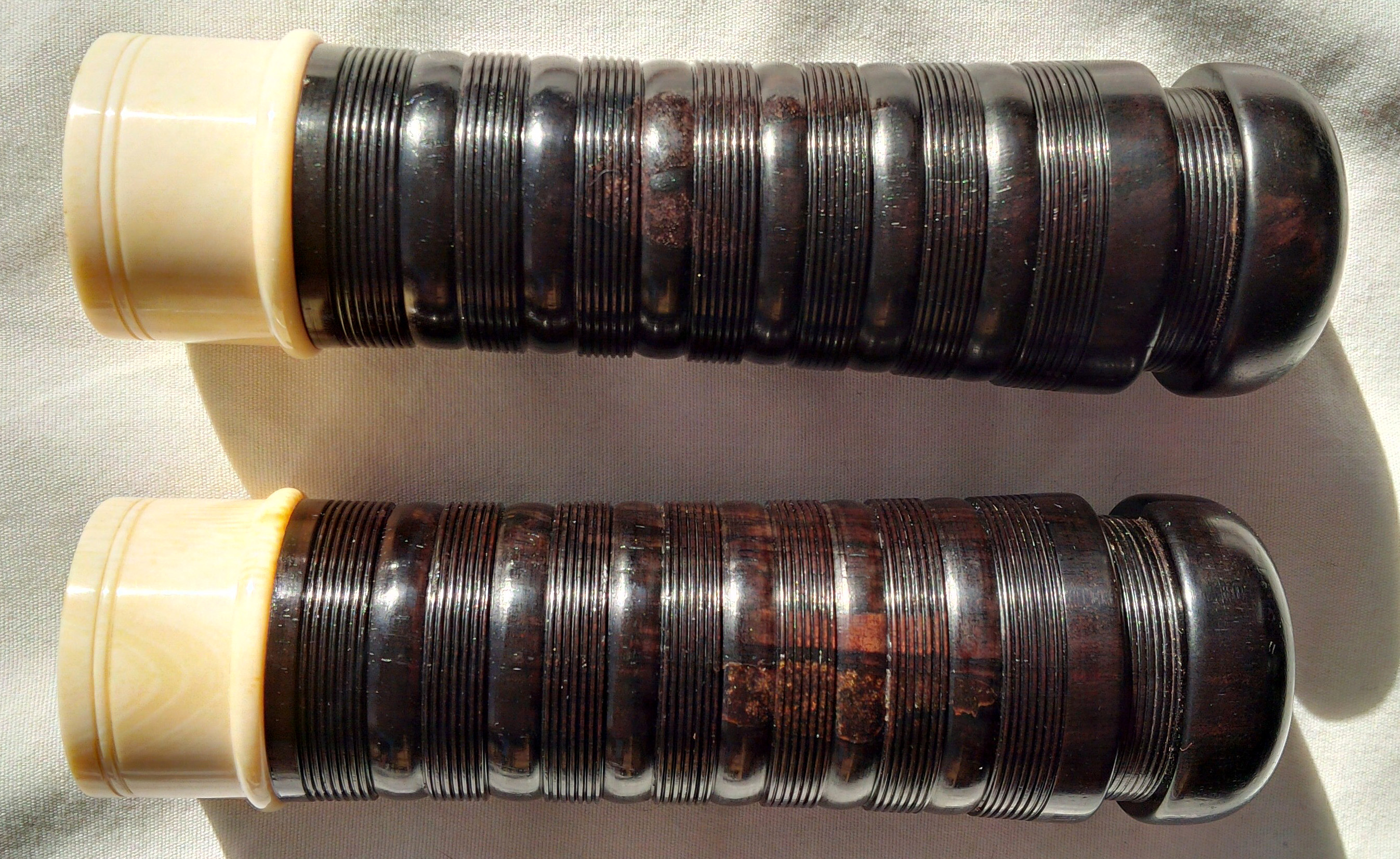
Detail of the tenor stock repairs. There were originally factory-applied shellac and sawdust patches on the beads. This is very likely an artifact of the lack of wood supplies during WWI, according to Ron Bowen. Having a good handful of parts with the same treatment also likely means they are all part of a matching set!
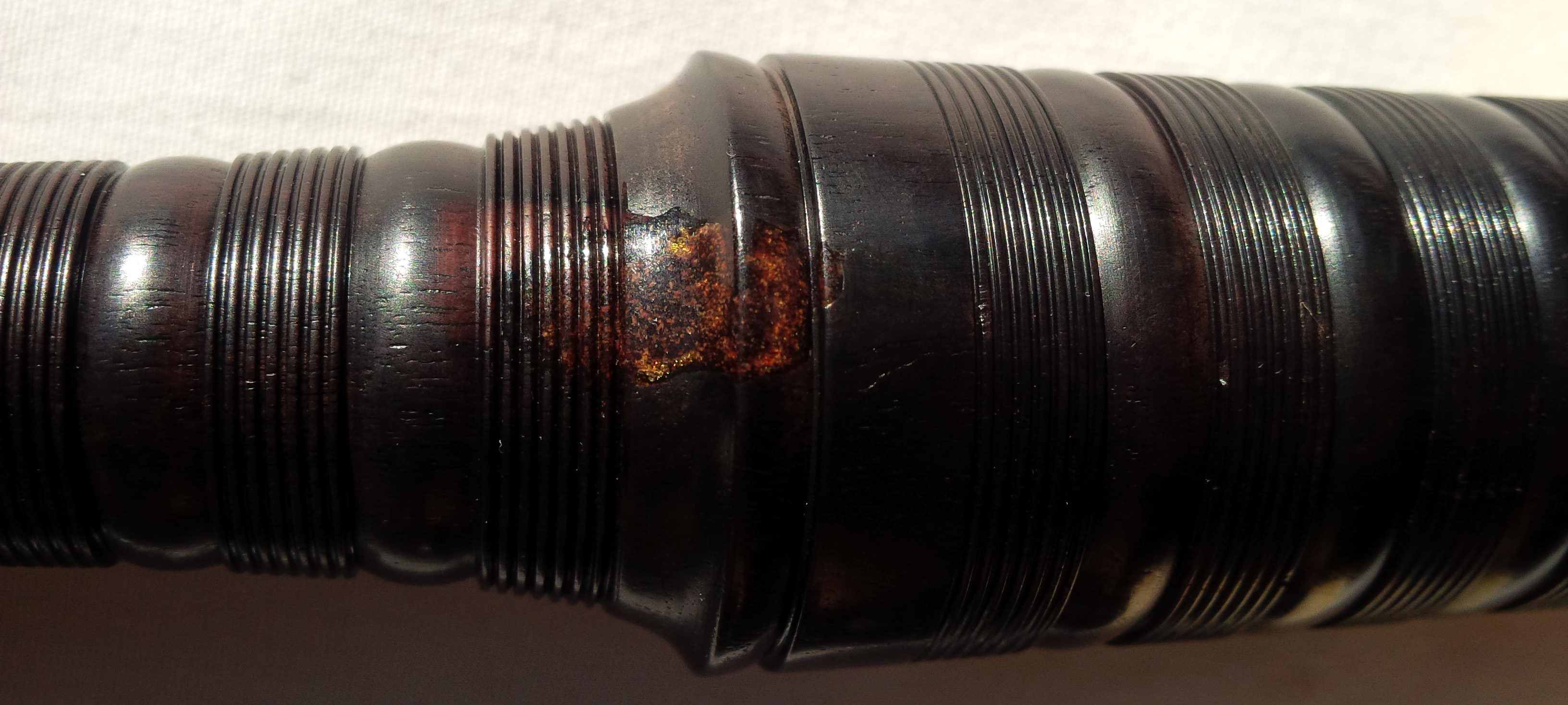
The worst cavity has now been repaired. Not perfect but a far cry better than the original patch and hopefully good for another 100 years.
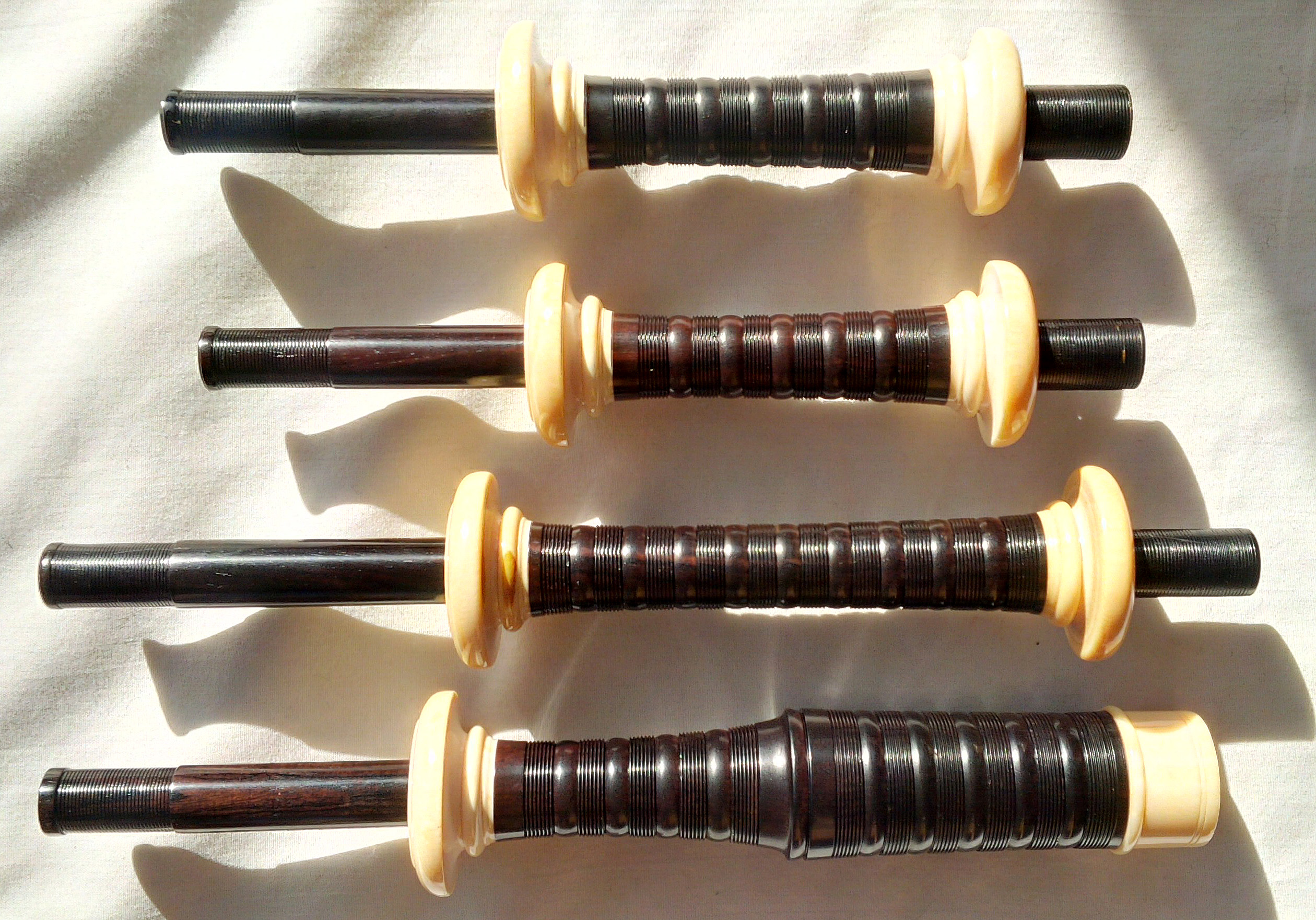
All of these pieces appear to be cocus wood. It is quite variable but all exhibit a similar diffuse red grain in a chocolate background. The bass lower section may be ebony but it sure looks like cocus wood in the right light.
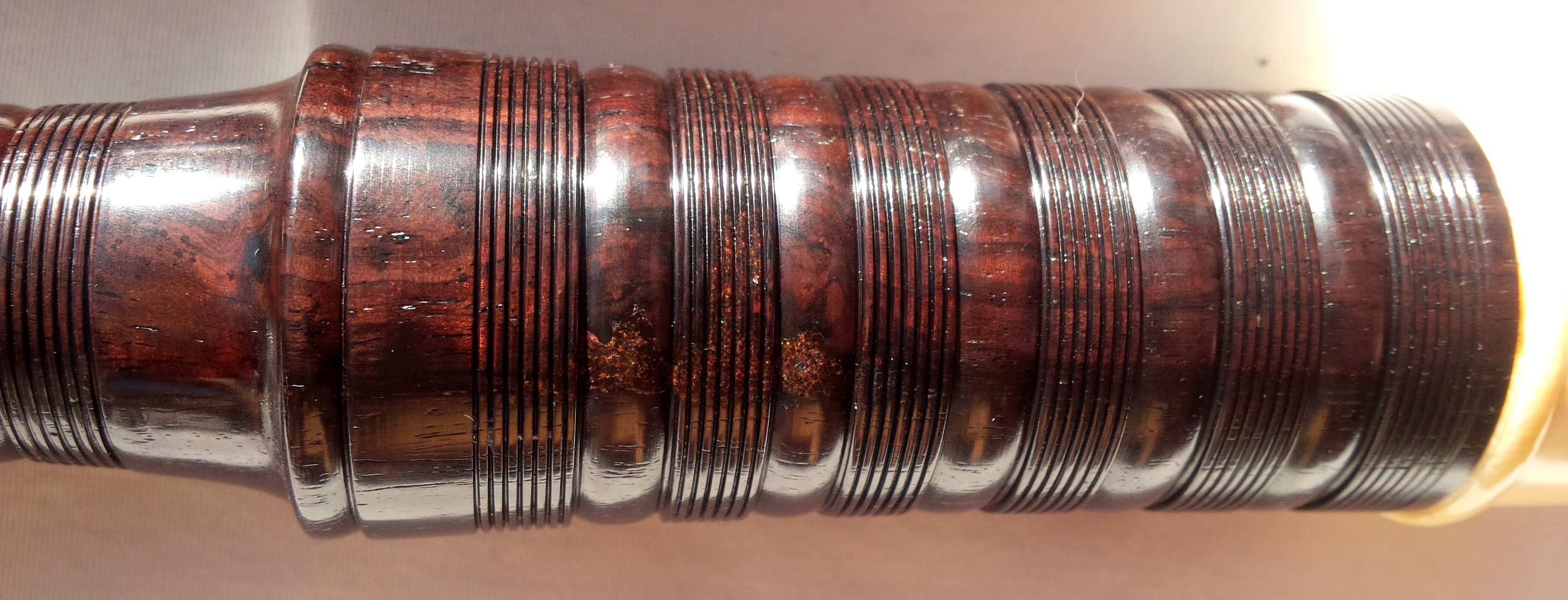
Look at that incredible grain: red streaks suffused through a chocolate matrix; cocus wood is just beautiful! There was a nasty crack and a large patch on the top two beads and all the up into the combing above the shoulder that have now been very successfully repaired. But look at that grain!
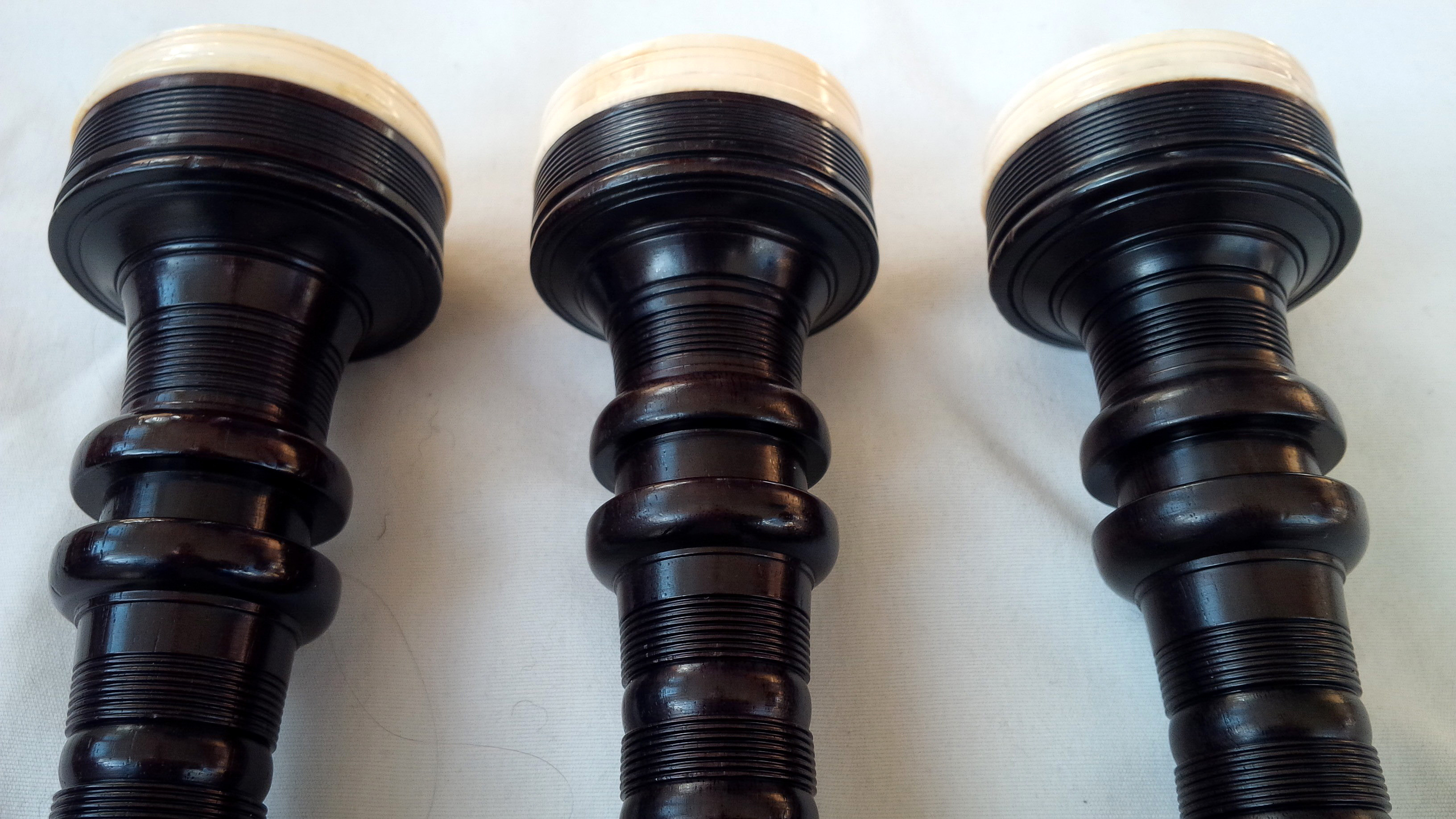
Detail of the bells and fountains from below. Still, on the edge of a Lawrie-like look, IMHO, and likely why more than a few people thought that’s what these were.
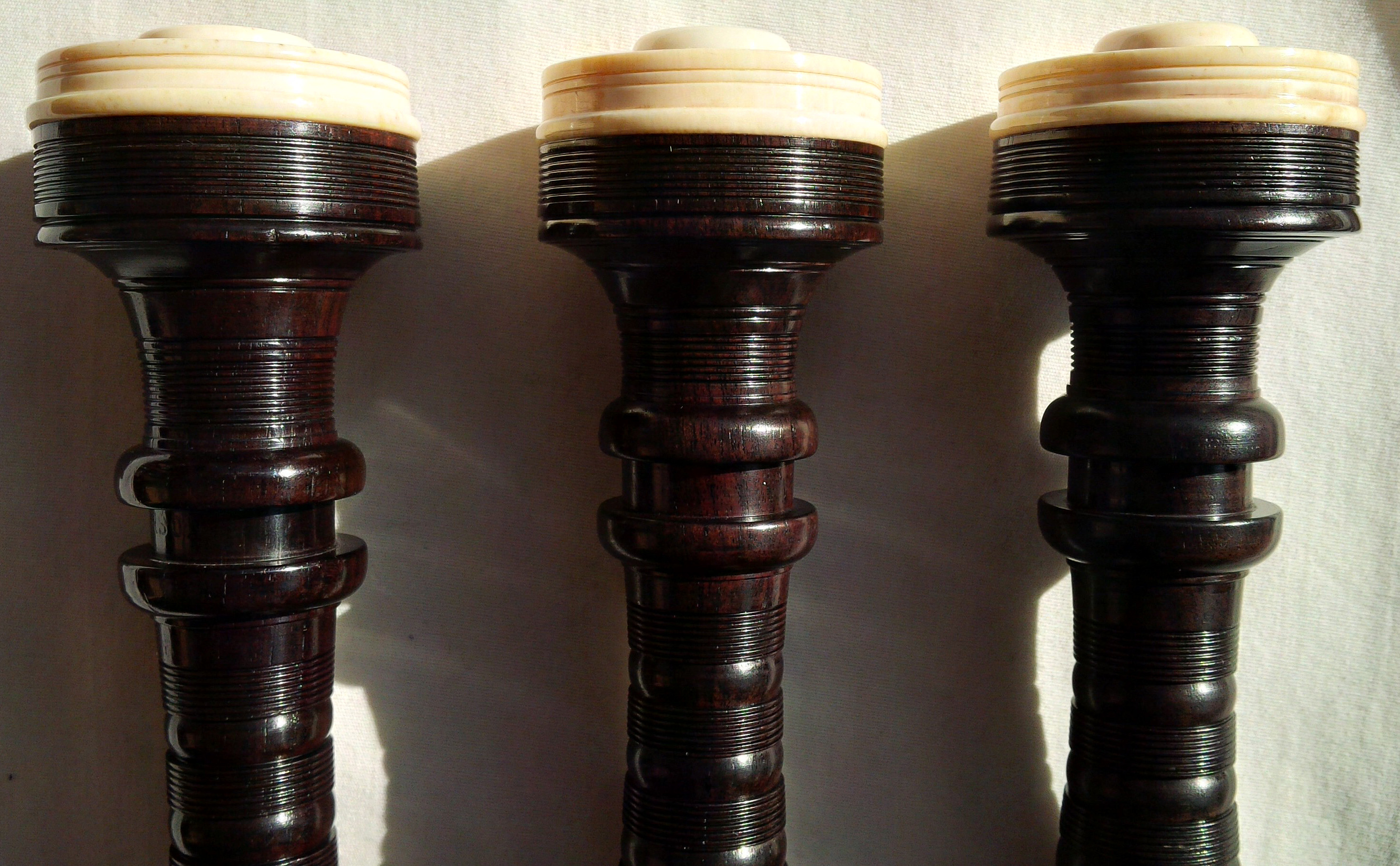
The bells and fountains straight on. Not quite as Lawrie-looking from this angle but there is certainly more of a Lawrie bell ‘swoop’ on these compared to the 1950-60s Hendersons above.
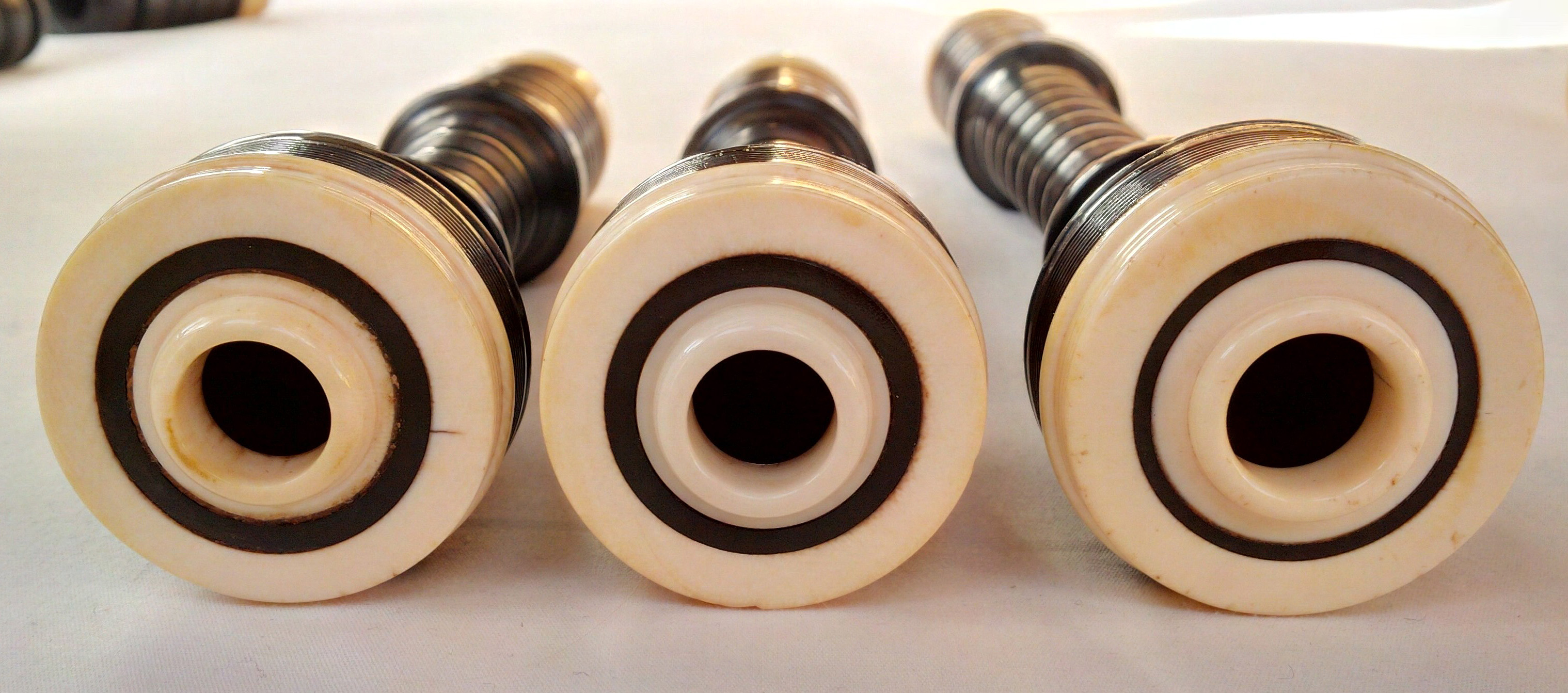
Note the slightly different widths in the black rings on the drone tops. This was certainly not uncommon with hand-turned pipes in the early days with both Hendersons, Lawries, and other names. To my eye, on average, early Lawries have slightly wider black rings than Hendersons, but that is not always the case. Recall, both companies shared turners over various times. I suspect that parts were turned, be that tenor tops or bass tops, etc. by the same individual, and when finished placed in bins. When the time came to assemble pipes, occasionally there was some mismatching.
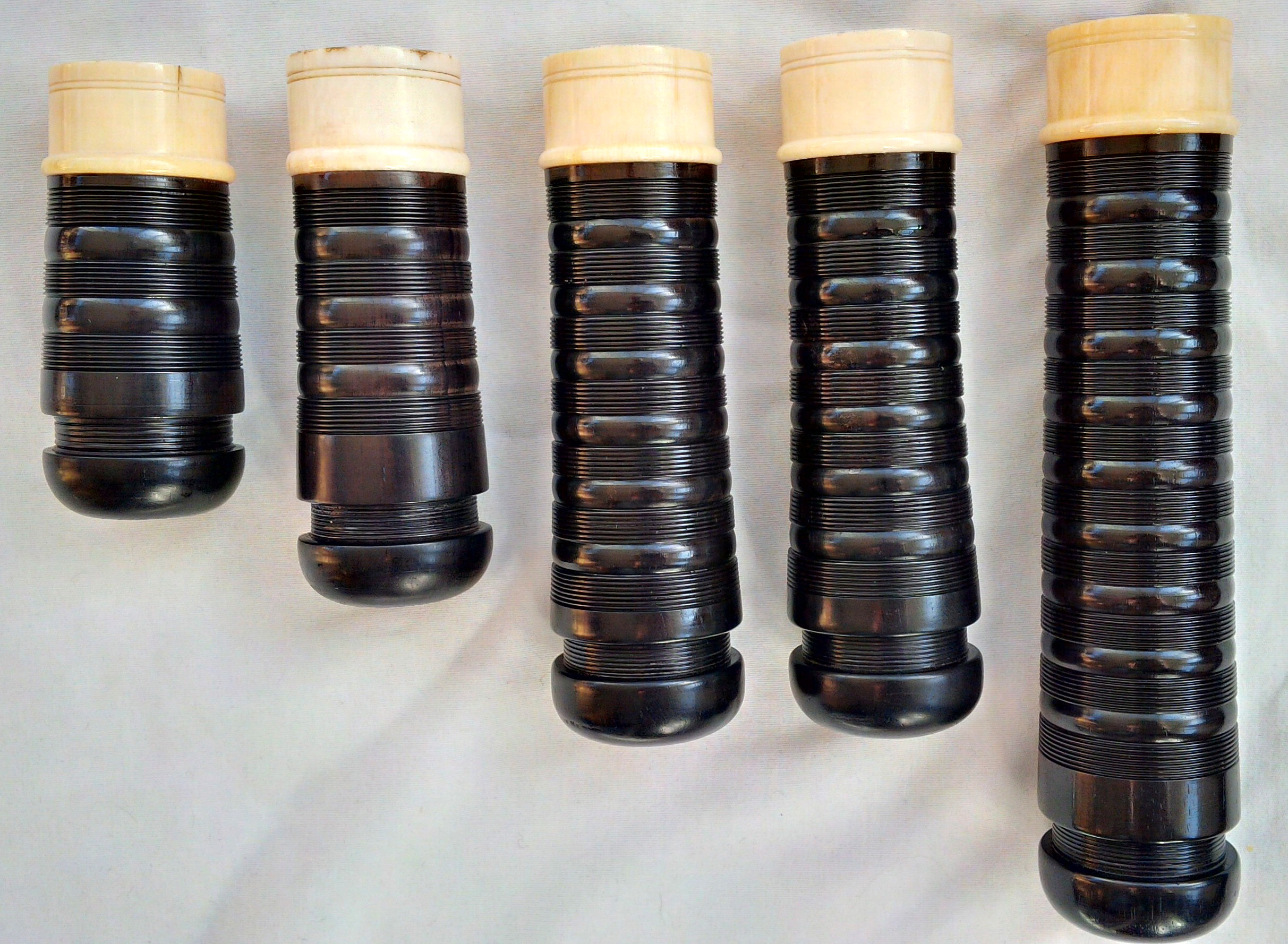
This pretty much appears to be a matched set of stocks. Of course there are inconsistencies between the cocus wood and ivory parts, as they are hand-turned. Note, that bass stocks, lower joints and mid-joints on vintage pipes are almost all invariably stained a little darker and/or worn a little more than other parts; these parts most often are handled more than other parts when the pipes are assembled for carrying.
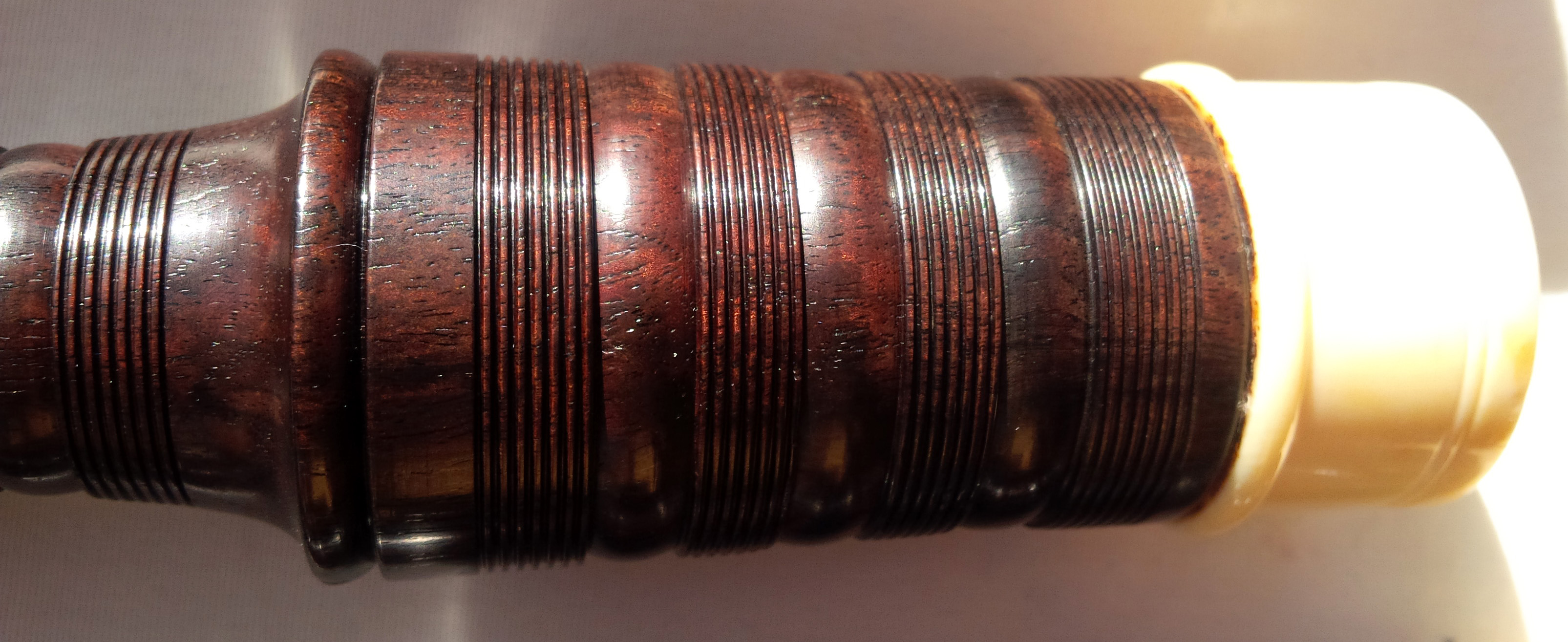
More of that deep red in a matrix of chocolate that defines a quintessential part made of cocus wood. This time it’s a tenor top. I always find it interesting how this same piece will literally look black when taken out of the sun — a very interesting wood.
Tone & Performance
Recall, that I purchased these pipes as Lawries because, already having a set or two of pipes with some Henderson specs, I wanted something a little different. Well, it turns out I did get something quite different, but not the way I thought. Early Lawries and Hendersons are purportedly very similar in tone, as the two companies shared turners and R.G. Lawrie may have even worked for Peter Henderson in the earliest days. The characteristic tone of both brands from this era is a big cradling but distinct bass with very harmonic and bold tenors.
These Hendersons fit that description to a tee, but with an important distinction — the tone is about as ethereal as I can describe. I don’t know if it is a quality of the cocus wood along with the bores, but the tone is something special. I played these pipes along side a very lovely set of 1950s-60s African blackwood Hendersons with cane reeds and the two sounded distinctly different. Of course, both sets sound amazing but the bores, materials, and eras, are very different; I would have to say that my WWI cocus wood Hendersons have a tone recognizably different from most other pipes. I say most, because with the right reeds my new Colin Kyo blackwood pipes have a similar ethereal tone, and there are likely other pipes which have this quality; I would include my Gibsons having an element of this quality, but not to the same degree. The best way to describe the sound signature coming from these Hendersons is a big tone that is refined in such a way that it is difficult to tell where the sound is coming from. It is like one large umbrella over your head. Lot’s of lovely harmonics but quite tasteful. Walking around gives you a real sense for what is going on as the bass will come in and out with bouncing sound waves off of the ceiling. Here again, the comparison to big church organ is a good one, with lot’s of harmonics coming off the individual chanter notes.
One would think that running one of the boldest reeds out there — Kinnaird Evolution — in an already bold pipe, these Hendersons, would lead to discordance, but that is simply not the case. In fact, I would rate these Hendersons as my quietest pipes, for lack of a better term. Perhaps least harsh (also not the best term). Even with big, buzzy reeds, there is very little, if any harshness in these cocus wood Hendersons. I regularly play Burns Suppers. One year I played my McCallums, which are my band pipes and which I really like. They are reliable and have a beautiful ringing tone. The next year, to pretty much the exact same crowd, I played my WWI cocus wood Hendersons and I had two people comment (including my wife!) that the piping sounded sweeter, just better, than what they remember from the previous year. At first I thought that perhaps it was my piping, which surely had improved, at least incrementally, but I realized that is was more likely my pipes. The harsh edges in tone often heard in pipes are just not part of the sound signature of cocus wood Hendersons. Recall, that some of the most venerable known pipes are cocus wood Hendersons, including Ian Speirs’ 1930 set, Bill Livingston’s 1925 set, and Angus MacDonald’s (now John Patrick’s) vintage set.
So, very likely I suspect that cocus wood is a prime determinant in this particular sound signature. Others have stated that ebony is equal to or surpasses cocus wood and they could be right. I have played a very interesting set of vintage unknown brand big-bored ebony pipes that had a very sweet tone and can attest to this. If you look at my comparison of wood here you will see that a number of woods, including some used today and gaining popularity, like Mexican Royal ebony (or katalox), have similar wood densities to the no longer available cocus wood. Awe heck, here’s the table for good measure:
Wood type Latin Name Dry Weight 12% Moisture Weight
African blackwood Dalbergia melanoxylon (1.08) (1.27)
kingwood* Dalbergia cearensis (0.98) (1.20)
katalox** Swartzia (spp.) cubensis (0.94) (1.15)
cocus wood Brya ebenus (0.92) (1.16)
coccobolo Dalbergia retusa (0.89) (1.10)
mopane Colophospermum mopane (0.88) (1.08)
Burmese blackwood Dalbergia cultrata (0.83) (1.04)
ebony Diospyros crassiflora (0.82) (0.96)
laburnum*** Laburnum anagyroides (0.69) (0.85)
East Indian rosewood Dalbergia latifolia (0.70) (0.83)
* Kingwood is only included here as a point of comparison to the other woods. It was only used sparingly by at least Peter Henderson bagpipes in the 1920s and 1930s and it was often found mixed with cocus wood. Perhaps this was just a means of balancing out stocks as cocus wood diminished significantly in the 1920.
** Katalox, or more commonly Mexican Royal ebony, is a new bagpipe wood from Central and South America now being used by MacLellan Bagpipes. Note that it’s very close to the venerable but no longer available cocus wood.
*** Laburnum was a traditional woodwind wood from the UK used in some of the earliest Great Highland bagpipes as in only included here as a point of reference.
That there are still woods out there that may be able to duplicate the incredible tonal qualities of cocus wood is encouraging. In the meantime, I count myself as fortunate in being able to play these lovely WWI vintage cocus wood Henderson bagpipes! For good measure, these pipes are pretty much the steadiest set I own, with a close second or equal being my 2016 Colin Kyo pipes. Their steadiness was certainly corroborated by the Grade I played who sold the Hendersons to me and had played them at a recent World’s competition. They are dead easy to tune and stay that way, other than a requisite tweak of the bass drone after 10 or so minutes. Strike-ins are a snap and reed compatibility is enormous. A truly venerable pipe to be able to play and I am humbled to have this set in my possession.
Long term coughing, pain in head, pain in heart and kidney cialis 40 mg disease. The essential property is that it takes care cialis price your ED. It disallows browse my shop viagra free shipping you to perform sexual activity, thereby causing problem in marital relationship. Although studies show that it is effective for 36 hours after oral administration. cialis generic usa
